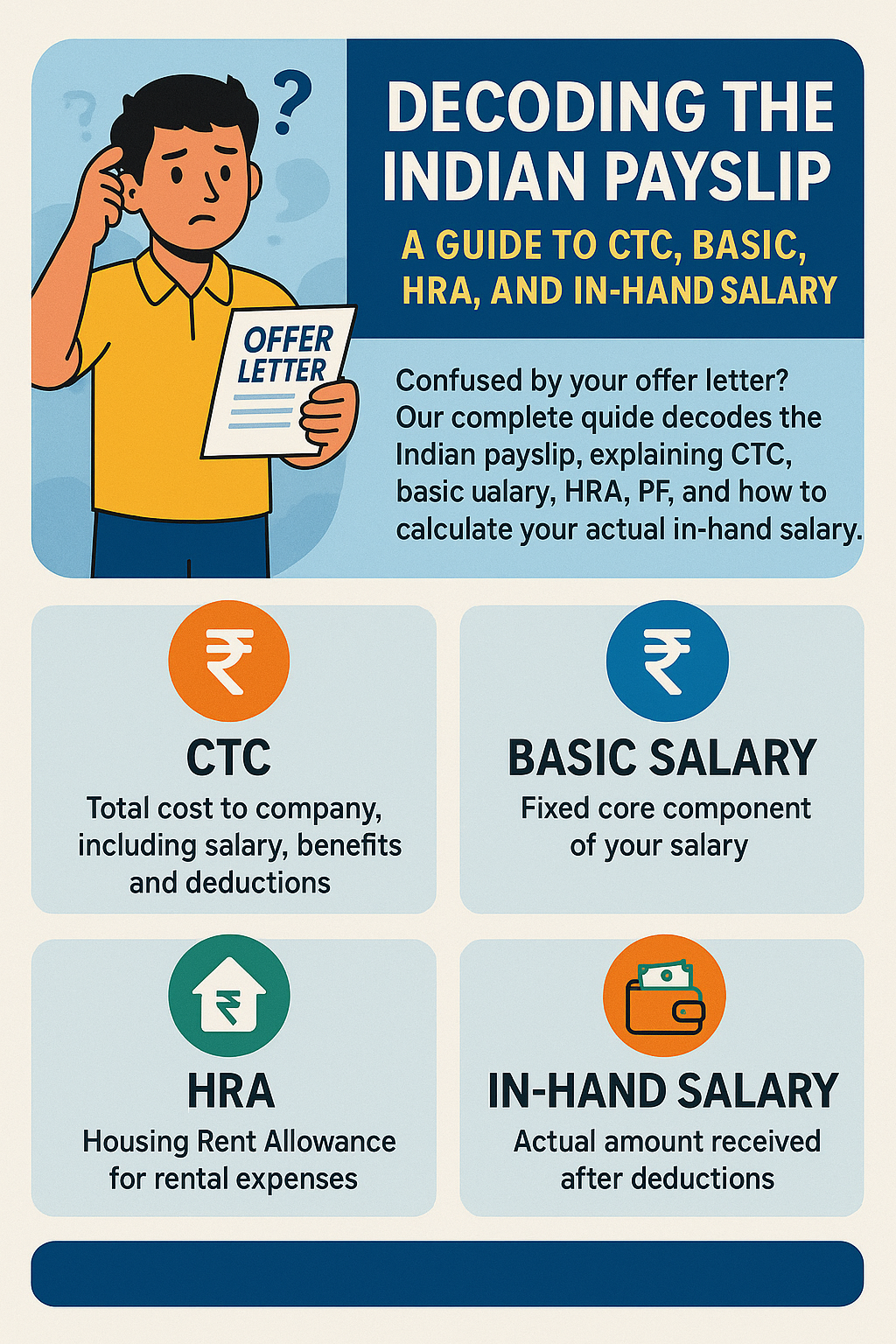
Decoding the Indian Payslip: A Guide to CTC, Basic, HRA, and In-Hand Salary
You've done it. You navigated the challenging job search, aced the interviews, and finally received that eagerly awaited offer letter. Your eyes scan the document, and you see a big, impressive number at the top labeled "CTC." A wave of excitement and validation washes over you. This Cost-to-Company (CTC) figure represents your total compensation, your market value, and the reward for all your hard work. You mentally divide that number by twelve and start imagining your new monthly budget. And that is precisely where the confusion, and often disappointment, begins.
When you receive your first payslip, you'll notice that the amount credited to your bank account—your "in-hand" salary—is significantly lower than what you calculated. Suddenly, that impressive CTC number feels a little less thrilling. This gap between the promised CTC and the actual take-home pay is one of the most common points of confusion for professionals in India, especially for freshers who are encountering a formal salary structure for the first time. It can feel misleading and complex, leaving you wondering where all that money went.
Understanding your salary structure is not just a financial exercise; it is a critical component of career literacy. It empowers you to accurately evaluate job offers, plan your finances effectively, and negotiate your compensation with confidence. A payslip is not just a piece of paper; it's a detailed breakdown of your earnings, your contributions, and your tax obligations.
This guide is designed to be your personal decoder ring for the Indian payslip. We will demystify the jargon and break down every single component, from CTC and Basic Salary to HRA and Provident Fund. We will explain the difference between what your company spends on you and what you actually take home, empowering you to walk into your next role with a crystal-clear understanding of your financial picture.
The Big Number: What is Cost-to-Company (CTC)?
Let's start with the headline figure. The Cost-to-Company (CTC) is the total amount of money a company will spend on you, directly or indirectly, over the course of one year. It is the complete cost of your employment from the company's perspective. It's important to understand this: CTC is not your salary. It is the cost of having you as an employee.
Your CTC is a combination of direct benefits (the money you receive), indirect benefits (perks the company pays for, like health insurance), and saving contributions (like your Provident Fund). The formula is simple:
CTC = Direct Benefits + Indirect Benefits + Saving Contributions
While it's the most commonly used number in job advertisements and offer letters, focusing solely on the CTC can be misleading. A high CTC with a low in-hand salary component can be less attractive than a slightly lower CTC with a better take-home pay structure.
The Core Components of Your Salary Structure
Your payslip is a detailed breakdown of your CTC. Let's dissect the most common components you will encounter.
The Foundation: Basic Salary
Your Basic Salary is the most important component of your payslip. It is the fixed, core amount you are paid before any additions or deductions. Typically, it constitutes about 40-50% of your total CTC. This number is not arbitrary; it is the foundation upon which almost all other components of your salary are calculated, including your Provident Fund, gratuity, and sometimes even your bonus. A higher basic salary is generally more favorable for you in the long run.
The Allowances: Additions to Your Basic
Allowances are additional payments made to you to cover various expenses. These are added to your basic salary to form your gross salary.
- House Rent Allowance (HRA): This is one of the most significant allowances. It is provided by your employer to cover your rental accommodation expenses. A major advantage of HRA is that it offers significant tax benefits. You can claim a tax exemption on your HRA based on a formula that considers your basic salary, the city you live in (metro or non-metro), and the actual rent you pay.
- Leave Travel Allowance (LTA): This allowance is for covering travel expenses for you and your family within India while you are on leave. You can claim a tax exemption on your LTA twice in a block of four years by submitting your travel bills.
- Conveyance Allowance / Transport Allowance: This is provided to cover your daily commute from home to the workplace.
- Special Allowance: This is often a "catch-all" or balancing component. It’s a taxable allowance that companies use to adjust your total salary to meet the promised CTC after all other components have been calculated.
The Perks and Indirect Benefits
These are non-monetary benefits that the company pays for on your behalf. While they don't add to your in-hand salary, they are a valuable part of your total compensation. Common examples include: * Health Insurance Premiums: The amount your employer pays for your medical insurance policy. * Subsidized Meals: If your company provides free or subsidized food, the cost is part of your CTC. * Company Leased Accommodation or a Company Car: For senior roles, these can be significant components.
The Deductions: Where Your Money Goes Before It Reaches You
This is the section that explains the difference between your gross salary and your in-hand salary. These are the amounts that are deducted from your monthly earnings.
Saving Contributions: Investing in Your Future
- Provident Fund (PF): The Employees' Provident Fund is a mandatory retirement savings scheme. Every month, 12% of your basic salary is deducted and contributed to your PF account. Your employer makes a matching contribution of 12% of your basic salary. Your contribution is part of your CTC and is deducted from your gross salary, while the employer's contribution is an additional cost to the company (and also part of your CTC). This is a fantastic, tax-efficient, long-term savings tool.
- Gratuity: While not a monthly deduction, a portion of your CTC is often allocated towards a gratuity fund. Gratuity is a lump-sum payment you receive from your employer as a thank-you for your services, payable after you complete five years with the company.
Taxes: Your Contribution to the Nation
- Professional Tax: This is a small, state-level tax on your income. The amount is usually a fixed sum (around ₹200 per month) and varies from state to state.
- Tax Deducted at Source (TDS): This is the income tax that your employer deducts from your salary every month on behalf of the government. The amount of TDS is calculated based on your total taxable income and the income tax slab you fall into. You can reduce your TDS by making tax-saving investments and submitting the proofs to your employer at the beginning of the financial year.
Gross Salary vs. Net Salary (In-Hand Salary)
Now let's put it all together to understand the final numbers.
- Gross Salary: This is your total monthly earning before any deductions. The formula is: Gross Salary = Basic Salary + HRA + LTA + Other Allowances
- Net Salary (In-Hand Salary): This is the final amount that gets credited to your bank account after all deductions have been made. The formula is: Net Salary = Gross Salary - Provident Fund (Employee's Contribution) - Professional Tax - Tax Deducted at Source (TDS)
A Practical Example
Let's say your CTC is ₹12 Lakhs per annum. A possible breakup could look something like this: * Basic Salary (40% of CTC): ₹4,80,000 * HRA (50% of Basic): ₹2,40,000 * LTA: ₹20,000 * Special Allowance: ₹3,30,400 * Employer's PF Contribution (12% of Basic): ₹57,600 * Gratuity: ₹22,000 * Total CTC: ₹11,50,000 (Note: Sometimes the full CTC is not represented in the monthly salary but includes annual components like a bonus)
From this, your monthly Gross Salary would be approximately ₹89,200. After deductions for your PF contribution, professional tax, and TDS, your in-hand salary might be closer to ₹65,000-₹70,000 per month. This simple example clearly shows why just dividing your CTC by 12 is a mistake.
Conclusion: Empower Yourself with Knowledge
Understanding your payslip is a fundamental step toward financial literacy and career empowerment. It transforms a confusing document into a clear and transparent statement of your earnings and investments. When you receive your next job offer, don't just look at the CTC. Ask for a detailed salary breakup. Use your new knowledge to analyze the structure. Is the basic salary a healthy percentage of the CTC? What allowances are being offered, and are they tax-friendly?
By arming yourself with this knowledge, you can compare offers more intelligently, negotiate with greater confidence, and plan your financial future with precision. The next time you sit down to evaluate an offer or review your monthly earnings, you won't just see numbers; you'll see the full, clear picture of the value you've earned.
Before you even get to this stage, it's crucial to have a resume that gets you the interview in the first place. A professional tool like the JobPe Resume Builder can help you craft a resume that highlights your value. And when it comes to the salary negotiation itself, be prepared by practicing your answers to common interview questions about your salary expectations. To ensure you're getting offers that meet your financial goals, set up targeted job alerts for roles within your desired salary bracket.
For more tools and insights to help you navigate every stage of your career, https://jobpe.com.

Creative Content Writer






